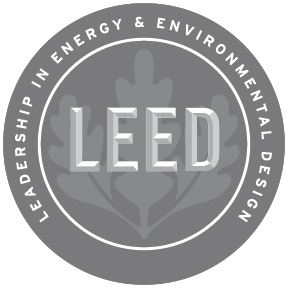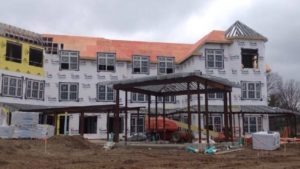Building Sustainability in Your Facility
Reducing energy and resource usage isn’t just good for the planet, it’s good for your bottom line, too.
Pop quiz: What’s your biggest operating cost? If you said energy, you’re not alone. Many senior living and long term care facilities list the energy to operate the building and power the lights as their biggest expense. It can also be costly to the environment, but there are ways to reduce your impact on the earth while also reducing how much money you have to shell out to the power company each month.

Michael Gerhardt, senior director, energy, construction, and facility management with Intalere
Michael Gerhardt, senior director, energy, construction, and facility management with Intalere, a St. Louis-based health care consultancy, works with senior living companies to find ways to reduce energy uses and incorporate other environmentally friendly upgrades that can increase comfort of residents while reducing operating costs. “It’s about spending money wisely,” he says, in finding opportunities to make the facility operate better while cutting waste.
Beyond that, becoming savvier about how you use resources can actually be a marketing point of differentiation that will attract environmentally conscious residents. People who came of age in the 1960s and 1970s when the environmental movement got going are starting to reach the age of needing assisted living or other senior care options. “Environmental concerns have been an interest all their lives, and it’s becoming more important to those folks to save energy and have a more sustainable environment to live in,” Gerhardt says.
Whatever your driving reason may be, making your business more environmentally friendly is a wise move. If you’re looking to green your operations, Gerhardt offers some tips about areas of your business to focus on.
1. Reduce Energy Usage.
There are lots of ways that energy can be wasted throughout most buildings, but paying attention to the following areas can help you slash your bills.
Temperature control. “These facilities run the gamut from being really nice, brand-new facilities to older facilities that might need maintenance and to be sealed up a little better and better,” Gerhardt says. The heating, ventilation and air conditioning system “is always the biggest expenditure,” he says.
But simply lowering the thermostat in winter and keeping it higher in summer isn’t the right answer. “That can be tricky in senior living — a lot of those folks are always cold. You have to give the client and the patient the ability to set the temperature to where they’re most comfortable.”
But, in common spaces or areas that aren’t in constant utilization, installing motion detectors or timers on the thermostat can help you lower the energy usage when the room isn’t in use. In addition, Gerhardt recommends reviewing when and how those spaces are used and consider instituting limits on how hot or cold the temps can be set to curb excessive energy usage.
Lighting. Does your facility make smart use of ambient light? Are there lights constantly left on? Gerhardt says lighting is a common source of wasted energy, but installing motion sensors can help ensure that the lights aren’t left on when a space is no longer in use. A simple switching of bulb types can also help. “LED lights save tons of energy. They’re probably four times as efficient as the old incandescent bulbs.”
Getting the lighting right isn’t just a cost or environmental issue — it’s a health issue too. “Lot of new studies are coming out about lighting and how when you have things over-lit, it can affect melatonin levels and people’s ability to sleep and get proper rest.” Science has found that nighttime light can disrupt sleep and may increase your risk of certain chronic diseases such as cancer. Therefore, “as much as possible, make sure the lights are out and spaces are dim at night. It will help people get their rest in and get their melatonin levels up.”
Safety is naturally a concern, but installing motion sensors that trigger accent lighting at floor level can help light the path to the bathroom at night without turning on all the overhead lights.
Building envelope. Especially in older buildings, how’s the state of your building envelope? This is the outer “skin” of the building that protects the inside from the outside. There’s a lot that can be done with tightening up the envelope, from replacing leaky windows and skylights to blowing insulation into the walls to reduce how much energy leaks from the building to the outside environment.
Install your own energy sources. Adding some solar panels to the roof or a small wind turbine to your campus could help you generate some energy and reduce the amount you need to purchase from the power company. In some cases, you may actually be able to generate more sustainable energy than you need using solar panels and other means, and you might be able to sell some of this energy back to the power company.
2. Reduce Water Usage.
As the climate changes, certain parts of the country are experiencing droughts. “Especial in states like California,” which have been hard hit by drought in recent years, being mindful of how much water you’re using is becoming increasingly important, Gerhardt says. Even if water is in abundance in your neck of the woods, seeking to limit water wastage is not only good for the planet but good for your wallet too.
Install low-flow fixtures. Do you have low-flow shower heads and toilets in all parts of your building? Also, make sure that shower heads and faucets are switched off properly and aren’t leaking.
Landscaping and the grounds. Consider which plants you’re using to landscape and beautify the grounds around your building. Can you swap out water-hungry flowers for native plants that need less water or fertilizer and will thrive in the local environment?
3. Source Safe Materials.
The materials you use to build and furnish your facility can also have environmental impacts. Perhaps more to the point, the can also impact resident health. Gerhardt says you should seek to put in “the right kinds of flooring and paint that don’t have volatile chemicals.” Materials that contain these chemicals continue to off-gas, or give off chemicals that could potentially cause health issues in some individuals. Steering clear of such substances can make your building a healthier place to live.
4. Seek a Seal of Approval.
 Some facilities want to earn LEED certification, a designation offered by the U.S. Green Building Council that is a mark of excellence for environmentally friendly buildings. For your building to achieve LEED status, it must meet certain requirement and contain certain features.
Some facilities want to earn LEED certification, a designation offered by the U.S. Green Building Council that is a mark of excellence for environmentally friendly buildings. For your building to achieve LEED status, it must meet certain requirement and contain certain features.
Achieving LEED certification “is a big interest to higher-end clients,” Gerhardt says, and carrying a LEED seal can be a differentiator for your building because it says this facility “was built with the environment in mind. It’s a healthier place for me or my family to live.”
Not every senior living facility will be able to achieve certification, but you can certainly borrow some of their approaches and include LEED features in your building to make it a safer, healthier, more productive, and less wasteful place. “I’m finding a lot of people are using LEED lights, but they’re not interested in getting the full certification,” Gerhardt says. But he encourages senior living companies to take a look at LEED principles and see if there are any you can “adopt at a reasonable cost and put some of those features in your building.”

Elaine K. Howley is a freelance journalist for various publications. An award-winning writer specializing in health, fitness, sports and history, her work has appeared in numerous print and online publications, including U.S. News, AARP.org, espnW, SWIMMER magazine and Atlas Obscura. She’s also a world-record holding marathon swimmer with a passion for animals and beer. Contact her via her website: elainekhowley.com.
Related Articles
Topics: Design , Facility management , Featured Articles , Housing , Operations , Senior Environments











